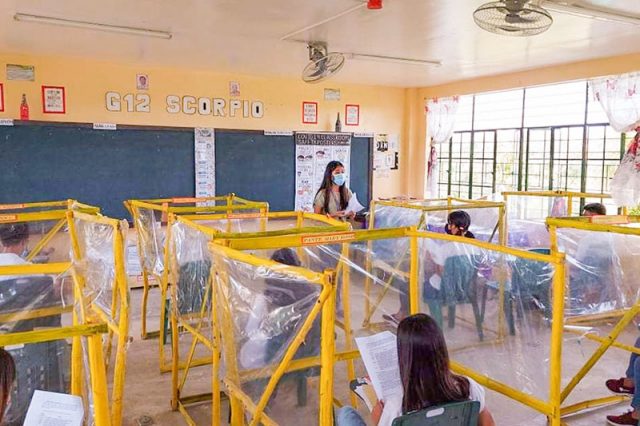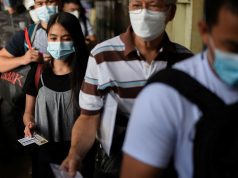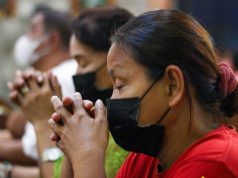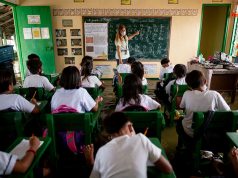
The Department of Health released guidelines for proper air ventilation to prevent the spread of COVID-19 after two years into the still prevailing coronavirus pandemic.
DOH also mentioned that COVID-19 is an “airborne disease.” Experts have been telling this to authorities since last year.
“Panalo ang proteksyon sa good ventilation!” the health agency said.
“Ang COVID-19 ay isa ring airborne disease o nananatili sa hangin sa mga indoor spaces. Kaya mahalaga na may good ventilation para maiwasan ang pagkalat ng aerosol o maliiit na particles ng virus sa hangin!” it added.
“Siguraduhing may mask, hugas, iwas, at airflow! Tandaan: kahit bakunado, pagiingat itodo!” DOH further said.
Panalo ang proteksyon sa good ventilation! ☢️💨
Ang COVID-19 ay isa ring airborne disease o nananatili sa hangin sa mga indoor spaces. Kaya mahalaga na may good ventilation para maiwasan ang pagkalat ng aerosol o maliiit na particles ng virus sa hangin! 👍 pic.twitter.com/gh144le1o5
— Department of Health (@DOHgovph) January 29, 2022
DOH gave the following tips to improve air ventilation in indoor spaces in a series of infographics:
- Buksan ang pinto at bintana.
- Buksan ang electric fan o exhaust fan.
- Gumamit ng air filter.
- Kapag magkakaroon ng interaksyon, dapat may isang metrong physical distancing at eksakto lang ang lakas ng boses.
- Kapag nasa kotse, gamitin ang fresh air mode para may ventilation pa rin.
It also pointed out that crowded indoor spaces still pose greater risks of spreading the disease than areas with fewer people and better airflow.
Members of the medical community have been advocating for proper indoor air ventilation to the government since last year.
These calls came after several studies and health experts have shown evidence that strongly supports the airborne transmission of COVID-19.
The World Health Organization also updated its own Q&A about the disease. It stated that a person can transmit the virus via “short-range airborne transmission.”
“Another person can then contract the virus when infectious particles that pass through the air are inhaled at short range (this is often called short-range aerosol or short-range airborne transmission) or if infectious particles come into direct contact with the eyes, nose, or mouth (droplet transmission),” WHO said.
‘Sa wakas’
Filipino doctors expressed relief that DOH finally admitted and accepted that COVID-19 is airborne.
They also hoped that the government would permanently rid of the use of face shields moving forward.
“Finally!” one doctor said with heart eye emoji.
“’Huli man at magaling, naihahabol din.’ Salamat po @DOHgovph para dito. Ngayon po, sana manguna kayo sa pangangalampag sa kinauukulan na ang mga polisiya ng COVID-19 response ay tunay na ipakita ang pagkilala na #COVIDisAirborne. Low hanging fruit: Iwaksi ang peyshield na yan,” another doctor with the handle @LopaoMD said.
“Sa wakas! After two years, nanindigan din na airborne ang SARS-CoV-2. So, tigilan na natin ang kahibangan ninyo sa face shields ha. Kumita na kayo dyan ng big time. Tantanan niyo na,” another doctor wrote.
Some online users also called on the DOH to release updated guidelines on improving airflow for businesses.
“One request from DOH. Since you are so eager to reopen the economy, can you provide ventilation & airflow guidelines for businesses operating on enclosed sides? You’ve not tackled HEPA filters, purifiers, etc,” one Twitter user said.
Last December, Jose-Luis Jimenez, a professor of Chemistry at the University of Colorado Boulder and one of the most highly-cited authors in 2021, cited the country’s setup of using glass or plastic barriers in schools as among the world’s “#COVIDHallofShame of worst practices” against COVID-19.
Given COVID’s method of transmission, researchers have found plexiglass barriers and other plastic dividers to increase the risks of infection in indoor settings than prevent it.
READ: Philippines’ plastic barriers in schools named under ‘world #COVIDHallofShame’s worst practices’









